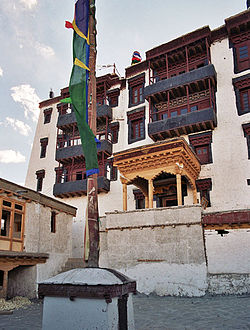This article needs additional citations for verification .(February 2023) |
| Stok Palace | |
|---|---|
 Stok Palace | |
| Religion | |
| Affiliation | Tibetan Buddhism |
| Location | |
| Location | Stok, Leh district Ladakh, India |
| Country | India |
| Geographic coordinates | 34°3′56.5″N77°32′32″E / 34.065694°N 77.54222°E |
| Architecture | |
| Founder | Lhawang Lotus |
| Date established | 14th century CE |
Stok Monastery or Stok Gompa is a Buddhist monastery in Stok, Leh district, Ladakh, northern India, 15 kilometres south of Leh. [1] It was founded by Lama Lhawang Lotus in the 14th Century and has a notable library including all 108 volumes of the Kangyur. A ritual dance-mask festival is held annually. [1] [ unreliable source? ]
Contents
Next to the monastery is a 71-foot (22 m) high seated Gautama Buddha statue and temple, constructed between 2012-2015 and consecrated by the 14th Dalai Lama on 8 August 2016. [2] [ unreliable source? ]
Around 2 km from the monastery is Stok Palace, built in 1820 as the summer home of Ladakhi royalty from the Namgyal dynasty of Ladakh.



